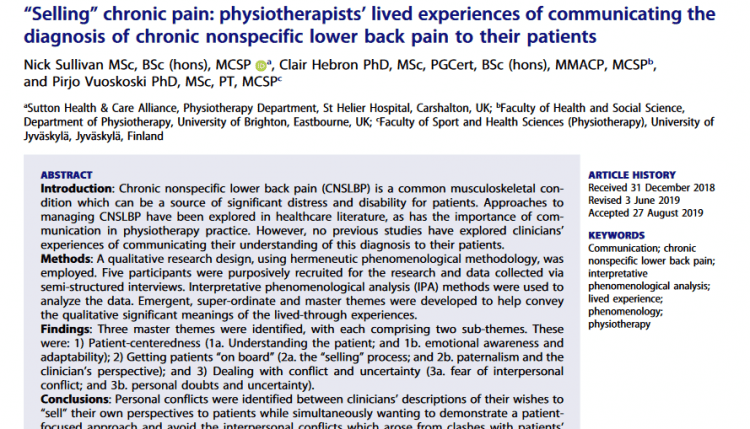
“Selling” chronic pain: physiotherapists’ lived experiences of communicating the diagnosis of chronic nonspecific lower back pain to their patients
Nick Sullivan , Clair Hebron and Pirjo Vuoskoski (2019)
https://www.tandfonline.com/doi/full/10.1080/09593985.2019.1672227
Abstract
Introduction: Chronic nonspecific lower back pain (CNSLBP) is a common musculoskeletal condition which can be a source of significant distress and disability for patients. Approaches to managing CNSLBP have been explored in healthcare literature, as has the importance of communication in physiotherapy practice. However, no previous studies have explored clinicians’ experiences of communicating their understanding of this diagnosis to their patients.
Methods: A qualitative research design, using hermeneutic phenomenological methodology, was employed. Five participants were purposively recruited for the research and data collected via semi-structured interviews. Interpretative phenomenological analysis (IPA) methods were used to analyze the data. Emergent, super-ordinate and master themes were developed to help convey the qualitative significant meanings of the lived-through experiences.
Findings: Three master themes were identified, with each comprising two sub-themes. These were: 1) Patient-centeredness (1a. Understanding the patient; and 1b. emotional awareness and adaptability); 2) Getting patients “on board” (2a. the “selling” process; and 2b. paternalism and the clinician’s perspective); and 3) Dealing with conflict and uncertainty (3a. fear of interpersonal conflict; and 3b. personal doubts and uncertainty).
Conclusions: Personal conflicts were identified between clinicians’ descriptions of their wishes to “sell” their own perspectives to patients while simultaneously wanting to demonstrate a patient focused approach and avoid the interpersonal conflicts which arose from clashes with patients’ beliefs. Building a good initial rapport, showing empathy and adapting approaches in response to perceptions of patients’ reactions were perceived as strategies to help mitigate the risks of failed communication, but this was something for which participants felt unprepared by their prior training.
